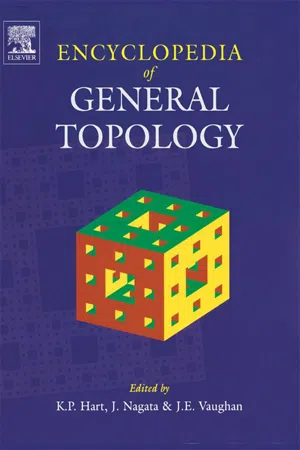A binary relation
on a set is a
quasiorder if it is
transitive and
reflexive. It is called a
trivial quasiorder if all-ways
x y, and is defined to be a
discrete relation if it agrees with equality; it is said to be an
order (sometimes simply called a
partial order) if it is
antisymmetric, that is, (∀
x, y) ((
x y and
y x) ⇔ (
x =
y)). A subset
Y of a quasiordered set
X is a
lower set if (∀
x, y) ((
x y and
y ∈
Y) ⇒
x ∈
Y); the definition of an
upper set is analogous. On a
topological space X set
x y iff every
neighbourhood of
x is a neighbourhood of
y. This definition introduces a quasiorder
, called the
specialisation quasiorder of
X. The terminology originates from algebraic geometry, see [
18, II, p. 23]. The specialisation quasiorder is trivial iff
X has the
indiscrete topology. The
closure of a subset
Y of a topological space
X is precisely the lower set ↓
Y of all
x ∈
X with
x y for some
y ∈
Y. The singleton closure {
} is the lower set ↓ {
x}, succinctly written ↓
x. The intersection of all neighbourhoods of
x is the upper set ↑
x = {
y ∈
X :
x y}.
A topological space
X is said to satisfy the
separation axiom T0 (or to be a
T0-space), and its topology
X is called a
T0-topology, if the specialisation quasiorder is an order; in this case it is called the
specialisation order. The space
X is said to satisfy the
separation axiom T1 (or to be a
T1-space), and its topology
X is called a
T1-topology, if the specialisation quasiorder is discrete. The terminology for the hierarchy
Tn of separation axioms appears to have entered the literature 1935 through the influential book by Alexandroff and Hopf [
3] in a section of the book called “
Trennungsaxiome” (pp. 58 ff.). A space is a
T0-space iff
Alexandroff and Hopf call postulate (0) “das nullte Kolmogoroffsche Trennungsaxiom” and postulate (1) “das er-ste Frechetsche Trennungsaxiom” [
3, pp. 58, 59], and they attach with the higher separation axioms the names of Hausdorff, Vietoris and Tietze. In Bourbaki [
4],
T0-spaces are relegated to the exercises and are called
espaces de Kolmogoroff
(see § 1, Ex. 2, p. 89). Alexandroff and Hopf appear to have had access to an unpublished manuscript by Kolmogoroff which appears to have dealt with quotient spaces [
3, pp. 61, 619]. It is likely to have been the origin of this terminology to which Alexandroff continues to refer in later papers (see, e.g., [
2]). Fréchet calls
T1-spaces
espaces accessibles
[
7, p. 185]. From an axiomatic viewpoint, the postulate (1) is a natural separation axiom for those who base topology on the concept of a closure operator (Kuratowski 1933); Hausdorff’s axiom, called
T2 by Alexandroff and Hopf, is a natural one if the primitive concept is that of neighbourhood systems (Hausdorff [
9] 1914). In [
14] Kuratowski joins the...



















